The truth is, I am a kid at heart. I see a bug and lose all fear, except if it is a bee, hornet or wasp, then I might run screaming while flinging my hat in the air around me.
I see paw prints in the dirt and want to get that Big-Foot impression.
The bones in the forest make me ponder the reason for the bones and to make sure they ARE not of the upright, two-legged variety and I then would like to do a "CSI Forest" segment.
 |
| Here I am...hiking thru the forest. |
My kind of inquisitive personality needs to be in the woods to explore an ever-changing environment.
All I want to do is get close enough to get a focused picture and usually must take shot after shot for a few good ones to be used for my blog. I'm glad I keep my camera close by because I've taken pictures of some pretty unusual things that I never expected to see. Often, I have no idea what I'm photographing; I just know that it has captured my attention and I'm in African Safari mode, if you know what I mean.
Oh, I've read YOUR blogs too, and I already know that YOU KNOW what I mean.
So, last week we stayed a few days on our acreage in the country and we drove into town to take a look at a few of the businesses that build small cabins and sheds.
During one quick walking tour of a few sheds and small cabins, we stumbled across this beautiful moth-looking creature that was quite large and more colorful than the camera is expressing.
Upon posting the photos on my blog, a couple of readers let me know that it appeared to be a Luna Moth, so I began to do some further research and have been amazed. Thank you Rae!
Luna Moths are currently listed as an endangered species. OF COURSE IT IS...
Who would have thought that we'd see so many threatened and endangered creatures in one weekend?
 |
| My IPhone photo of a Luna Moth --- a beauty to behold. It didn't move at all...motionless. |
Apparently, the Luna Moth is a member of the giant silkworm moth family and are RARELY seen since they fly ONLY at night. They are nocturnal insects and can be seen flitting around outside lights at dark. Their nocturnal nature has also given them the nickname, "Moon Moth."
This species is not a harmful moth. They are mostly found throughout the eastern forests of North America and lower Canada.
I guess this past weekend of seeing a rattlesnake and this moth, among other creatures, found us enjoying life in nature with unusual sightings. I could have lived without the rattlesnake experience though.
These Luna Moths begin life as tiny eggs laid on the underside of leaves with about 200 sibling eggs. Hatching takes place within ten to twelve days as caterpillars leave their egg habitat. Of course, these little dark brown eggs are busted as predators find them and chow down on their egg-goodness before the Luna Moth can continue its life-time of transformations.
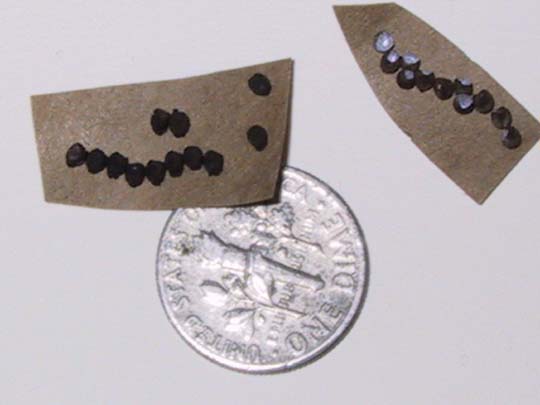 |
| From http://wormspit.com/Luna.htm I won't disturb any leaves I find on our land that have these eggs on the underside of tree leaves or that have cocoons. |
The hatched caterpillars emerge as hungry little boogers. This is their "Luna Larvae" stage and they do not waste time...they begin eating, immediately. They eat and they eat...life is about eating persimmon leaves, walnut leaves, butternut, hickory and sycamore leaves, but they will include on their menu a diet from the leaves of oaks, maple, sweet gum and willow. These ravenous larvae get plump and make for attractive wiggly live bird bait.
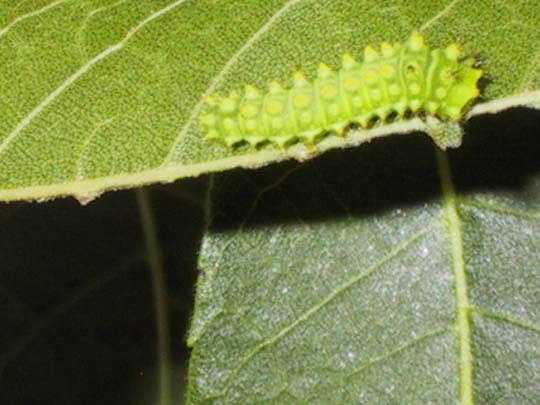 |
| http://wormspit.com/Luna.htm |
Now that I know these caterpillars are in the area of the acreage, I will be on the lookout for all stages of this Luna Moth. I will keep an eye out for caterpillars who are dining out in their Sunday best...it would seem they are outfitted quite beautifully with a yellowish-bright green body and a yellow stripe along their sides.
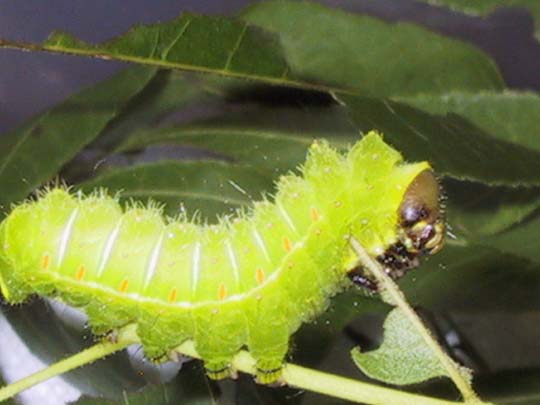 |
| http://wormspit.com/Luna.htm This photo shows the "Scoli" which are fine hairs. |
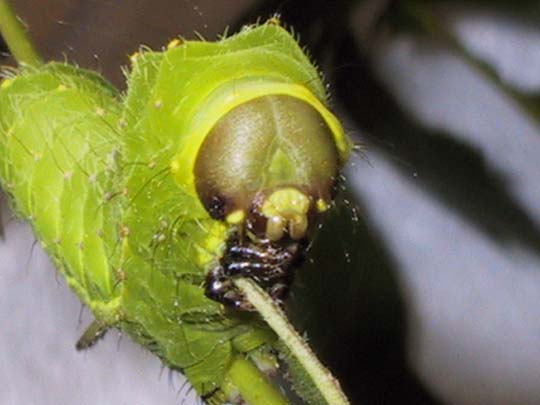 |
| http://wormspit.com/Luna.htm The older the caterpillar stage, the darker the head becomes. |
And they molt about five times in a four week time-frame because they continually eat so much and outgrow their skin, until they reach about 2 1/2 - 3 inches in length. They make their way crawling around as caterpillars for 3-6 weeks, depending on location...the farther North they live, the more chance this stage will last longer.
After all that munching and skin changing, the caterpillar will eventually be ready to "pupate." At this stage, they wrap themselves in leaves and spin themselves into a cozy silk cocoon, produced from their mouth. In their home of leaves and silk, they live dormant for up to three weeks. If they happen to have entered this stage just as winter settles in, they will then continue the cocoon stage until the following spring.
I found it very interesting that moths re-born from the cocoon are not able to fly right away, so they hang around to allow blood to circulate to their wings; blood inflates the veins of the wings and firms their wings. This step takes around 45 minutes or longer.
 |
| Deputy Dave's hand held up for perspective to show the large size of this Luna Moth. |
From the moment of flying away for their first night of exploration, their sole mission is to search for a mate. You could say this is their new obsession, especially since they have about one week left in life and they spend it as a stunning Luna Moth. All that time changing from egg to plump wiggler to an immobile cocoon phase is so they can one day become an object of beauty. In their moth phase, mating is their only obsession because the fatty days of being a munching caterpillar are long gone --- this flying stage means they have morphed into a beautiful creature that doesn't even have a mouth. During their cocoon stage, they lost their digestive system.
I guess in the moth world, there is a REAL price for beauty.
Come to think of it, I know a few women who might consider the loss of a digestive tract and the absence of a functioning feeder-mouth to be an excellent trade-off for unparalleled beauty.
Anyway, female Luna Moths release a chemical into the air that attracts males who speed to the scene because it is first come, first serve...with no time to waste. Following the moths mating in an episode of "Afternoon Delight," the female finds a few nice leafy undersides to deposit her eggs, then she dies shortly thereafter. I suppose laying approximately 200 eggs will do that to you.
Hence, with the freshly laid eggs, 4-6 on each leaf, starts the entire process again with the next generation.
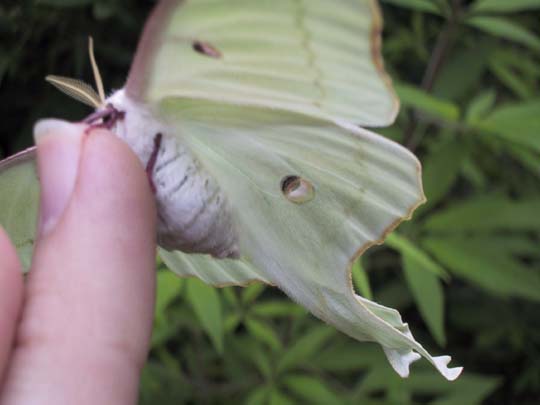 |
| http://wormspit.com/Luna.htm Belly full of eggs in this Luna Moth. |
Luna Moths are up to four inches in width and five inches tall with glorious coloring that can vary from yellow to green to blue, and I find it interesting that their coloration depends on their location. Their colors aid them in camouflaging themselves along the forest floor. The eye-markings on their wings help to prevent predators from targeting them.
The Luna Moth that we got to see so close up was during its day-time mode of being perfectly still, trying to blend in with the natural setting. However, this moth at the underside of the cabin porch roof didn't realize that it wasn't on a tree, but on a piece of wood in a people-zone.
 |
| I always need to have some sort of camera on me. Even though the IPhone does not have great quality for photos, it sure is nice to have a cell phone and camera combo. The camera has a super easy feature to make Facebook uploading a matter of pressing a couple of selections and BAM you are sharing on Facebook, sharing the photo via text, email or other transfers! |
Most moths are considered a pest, but it appears that Luna Moths do not harm their host trees because they are laid in eggs that are evenly spread out.
Between pesticides and street lights, there have been significant decreases in their population. Efforts to kill Gypsy Moths have caused Luna Moths to be caught up in the effort. And owls seem to love Luna Moths.
Their green coloring helps them to disguise themselves in the midst of leaves. The eye spots on their wings look scary to some of their enemies as their large wings flutter. Then, some would-be predators have learned that Luna Moths are not so tasty.
 |
| Picture of a Luna Moth, taken with my IPhone. |
My mother would be proud, I'm finally learning to LOOK and to NOT TOUCH.
3 comments:
Glad I was able to identify it for you! Lol.
I was fascinated by butterflies and moths when I was a kid, and the Luna moth was always my absolute favorite. Love that you went and researched them. Very cool critters!
Rae --- thank you! As you can see, I went into my detailed-overdrive mode to research the beautiful creature.
Can you believe it is endangered?
What kind of luck is that? I'm glad it didn't have the potential to be deadly poisonous. :-)
Lana
I'm okay with some bugs, but most I can't stand.
Oh well. I look forward to the coming changes in your blog. ;-)
Post a Comment